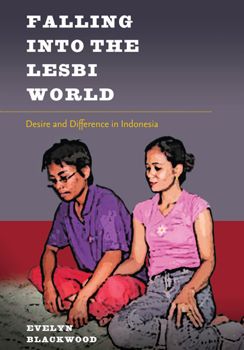Helen Pausacker
Evelyn Blackwood’s book is a fascinating and thought-provoking read, both for those interested in gender roles and issues in Indonesia and for anyone interested in queer theory or history. Blackwood’s research is based on in-depth interviews and participant observation of a small group of 16 participants, who were mainly working-class and lower middle-class. She focuses on Padang (West Sumatra), but she skilfully broadens a detailed description of the group she studied with comparisons to national, Asian and global examples.
Eight of Blackwood’s interviewees are tomboi (or cowok), who are biologically women but who self-identify as men, wearing masculine clothing and working in masculine occupations. The other eight women, the femmes (or cewek), self-identify as ‘normal women’, who are attracted to men. Blackwood is careful to avoid the use of the English terms ‘butch’ and ‘transgender’ for the tomboi, as she feels these do not precisely equate. On the other hand, she does use the English words ‘femme’ and ‘girlfriend’ for the cewek, even though the use of the English ‘femme’ seems equally as problematic: a femme lesbian would not, for example, consider that she is attracted to men.
Blackwood outlines the gender expectations for women and men in Indonesia and draws parallels between these and the behaviour of the tomboi and their girlfriends, demonstrating the influence of the wider society. Tomboi have much greater freedom, for example, when they can go out and where they can go to, or whether they can smoke. They are also more likely to be unfaithful than their cewek partners. On the other hand, the cewek in Padang tend to be faithful, to guard their reputations by not straying too far from home unaccompanied, do not smoke and perform more household chores.
Through observing the participants’ everyday actions, Blackwood reveals the ambiguity in lesbian identity and practices. She shows how the participants negotiate the boundaries between their different worlds, in ways that might seem contradictory to an outsider. For example, to avoid causing tension with their families many tomboi still live in their parental home, do some feminine chores and are addressed by feminine terms of address at home. In one section, Blackwood describes the strategy one tomboi uses to evade family expectations of marriage rather than directly refusing to marry. In other examples, one of the cewek and one of the tomboi married and had children to satisfy family expectations, later returning to the ‘lesbi world’. Elsewhere, Blackwood describes the dilemma faced by a tomboi about whether to use the men’s or women’s public toilet.
National and global interactions
Blackwood also details the ways in which the tomboi and their girlfriends in Padang perceive themselves as part of the national and global queer community. Her interviewees do not have access to computers, so they are unable to read online information from national lesbian, gay and transgender organisations. Nor could they receive newsletters if they lived in their parents’ homes. Their knowledge about other lesbian and gay identities and terminology is gleaned from references in mainstream media (newspapers and television); through people met when travelling; and through their links with male-to-female transgender people in Padang.
Blackwood notes that terminology learned by these circuitous means is then reinterpreted by the Padang group. While tomboi identify themselves as ‘men’ and their girlfriends see themselves as ‘normal women’, both sets identify as ‘lesbi’ (lesbian).The word biseks (bisexual) was used by one informant for a woman who had sex with both tomboi and feminine women and by another for ‘heterosexual’ married women who had sex with tomboi on the side. Interestingly, the cewek, who were attracted to men and tomboi (who they saw as men), did not consider themselves biseks.
Interaction with national lesbian organisations is not always smooth. When one tomboi from the Padang group went to a lesbian conference in Jakarta (where activists define ‘lesbi’ as women who are attracted to women), s/he was told that if s/he self-identifies as a man then s/he is not a lesbian but a ‘transgender’, a term which the tomboi had never heard before, and did not understand. Rejection goes both ways: in Padang, the group is put out by a new arrival to their group, who is going to university and who states that she is andro (neither tomboi nor feminine) and pressures her to conform to their norms.
Falling into the Lesbi World is rich with detail and Blackwood deftly describes the complexity of the sexual and gender identities of the participants with warmth and affection, making it an enjoyable read as well as a valuable academic contribution to a little-researched group of Indonesian society. The book is particularly interesting because it describes the point at which ‘old’ norms and behaviours come into contact with the ideas of ‘new’, ‘global’ (Western) lesbian/gay/queer culture, theory and terminology that have developed since the 1970s. Blackwood’s detailed observation is of one small group of people in one small area of Padang, but her book has a wider significance. She gives voice to views and describes lifestyles, which counter those norms ‘dictated’ by upper-class, highly-educated lesbians in capital cities. Her account offers an exciting change from accounts from the west, where the lives of older butch-femme lesbian couples were mainly recorded retrospectively, often through oral histories.
Evelyn Blackwood, Falling into the Lesbi World: Desire and Difference in Indonesia, Honolulu, University of Hawai’i Press, 2010.
Helen Pausacker (h.pausacker@unimelb.edu.au) works at the Asian Law Centre, Melbourne Law School, University of Melbourne.
